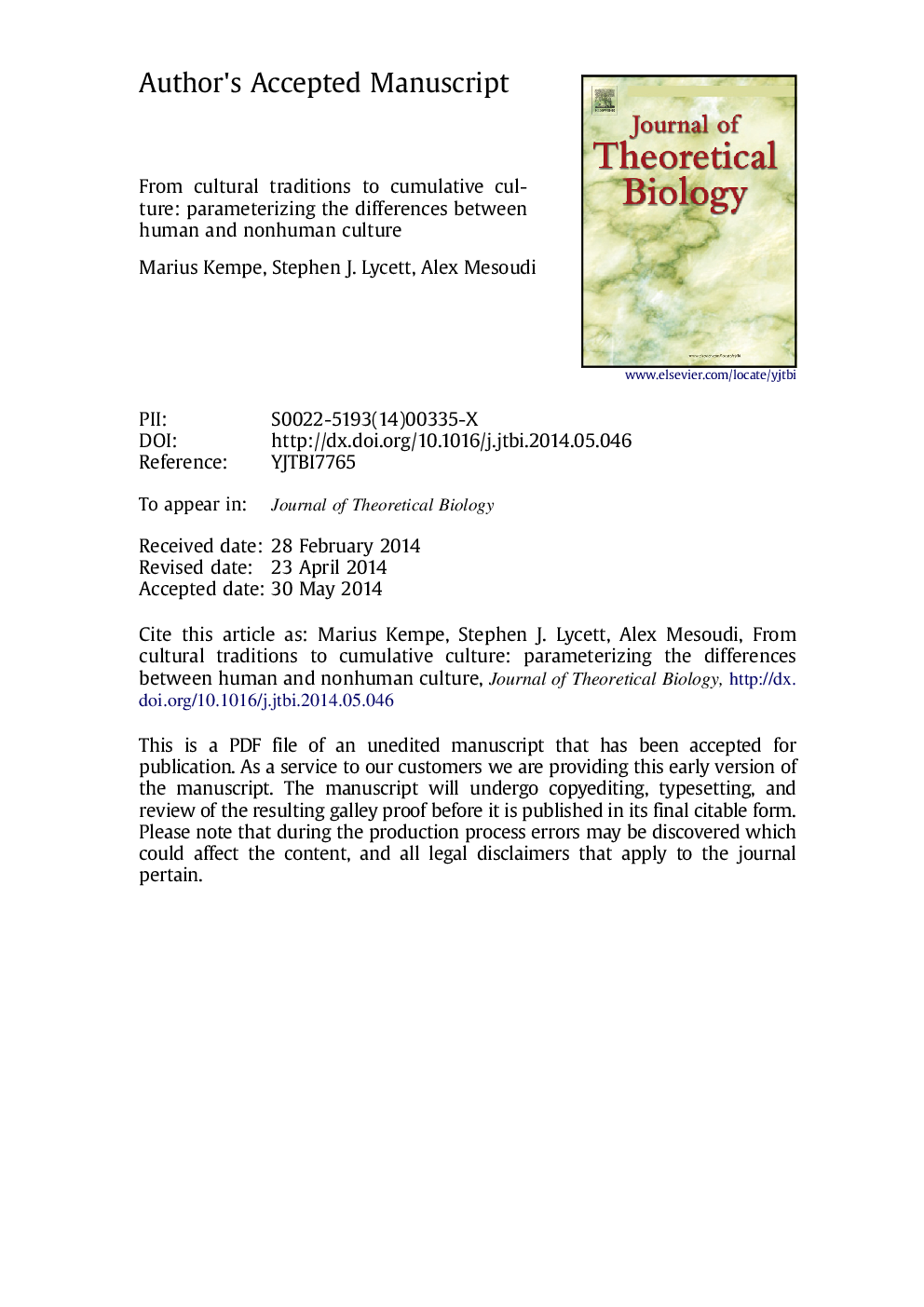| کد مقاله | کد نشریه | سال انتشار | مقاله انگلیسی | نسخه تمام متن |
|---|---|---|---|---|
| 6370319 | 1623851 | 2014 | 33 صفحه PDF | دانلود رایگان |
عنوان انگلیسی مقاله ISI
From cultural traditions to cumulative culture: parameterizing the differences between human and nonhuman culture
ترجمه فارسی عنوان
از سنت های فرهنگی تا فرهنگ تجمعی: تنظیم تفاوت بین فرهنگ انسانی و غیر انسانی
دانلود مقاله + سفارش ترجمه
دانلود مقاله ISI انگلیسی
رایگان برای ایرانیان
کلمات کلیدی
فرهنگ حیوانات، تکامل فرهنگی، دموگرافیک نوآوری، یادگیری اجتماعی،
ترجمه چکیده
گونه های گوناگون سنت های فرهنگی را نشان می دهند، از جمله پروفایل های خاص جمعیتی از ویژگی های یادگیرنده اجتماعی، از گویش های آواز خوانی به رفتارهای استفاده از پریمات. با این حال، تنها انسان به نظر می رسد دارای فرهنگ تجمعی است، که در آن صفات فرهنگی در طول نسل های متوالی در پیچیدگی افزایش می یابد. از لحاظ نظری، در حال حاضر مشخص نیست که عوامل ایجاد کننده این پدیده ها چیست، و در نتیجه، سنت های فرهنگی در چندین گونه، اما فرهنگ تجمعی در تنها یک یافت می شود. در اینجا ما با ساختن و تحلیل مدل های تکاملی فرهنگی هر دو پدیده ای که سطوح تایید کننده تجربی از تنوع فرهنگی و پیچیدگی در شامپانزه ها و انسان ها را تکرار می کنیم، به این مسئله می پردازیم. در مدل ما از سنت های فرهنگی (مدل 1)، ما می بینیم که تغییرات فرهنگی واقع بینانه میان جمعیت ها می تواند حتی زمانی حفظ شود که افراد در جمعیت های مختلف، ویژگی های یکسانی داشته باشند و مهاجرت بین جمعیت ها مکرر است و در سطوح سطوح دقت یادگیری اجتماعی. این به حمایت ادعا می کند که سنت های فرهنگی احتمالی در واقع منشا فرهنگی (به جای ژنتیک) است و نشان می دهد که سنت های فرهنگی باید در گونه هایی است که می توانند یادگیری اجتماعی را گسترده کنند. مدل مدل فرهنگ تجمعی (مدل 2) نشان می دهد که هر دو دقت یادگیری اجتماعی و تعدادی از تظاهر کنندگان فرهنگی برای تعریف پیچیدگی یک ویژگی که می تواند در یک جمعیت حفظ شود، تعامل دارند. ترکیب این مدل ها (مدل 3) دو رژیم کیفی متمایز را ایجاد می کند که در آن چند ویژگی ساده، یا بسیاری از ویژگی های پیچیده وجود دارد. ما پیشنهاد می کنیم که این رژیم ها به ترتیب به فرهنگ غیر انسانی و انسانی مربوط می شوند. نگرش فرهنگ تجمعی در طبیعت ممکن است از این تعامل بین دقت یادگیری اجتماعی و تعداد تظاهرکنندگان باشد.
موضوعات مرتبط
علوم زیستی و بیوفناوری
علوم کشاورزی و بیولوژیک
علوم کشاورزی و بیولوژیک (عمومی)
چکیده انگلیسی
Diverse species exhibit cultural traditions, i.e. population-specific profiles of socially learned traits, from songbird dialects to primate tool-use behaviours. However, only humans appear to possess cumulative culture, in which cultural traits increase in complexity over successive generations. Theoretically, it is currently unclear what factors give rise to these phenomena, and consequently why cultural traditions are found in several species but cumulative culture in only one. Here, we address this by constructing and analysing cultural evolutionary models of both phenomena that replicate empirically attestable levels of cultural variation and complexity in chimpanzees and humans. In our model of cultural traditions (Model 1), we find that realistic cultural variation between populations can be maintained even when individuals in different populations invent the same traits and migration between populations is frequent, and under a range of levels of social learning accuracy. This lends support to claims that putative cultural traditions are indeed cultural (rather than genetic) in origin, and suggests that cultural traditions should be widespread in species capable of social learning. Our model of cumulative culture (Model 2) indicates that both the accuracy of social learning and the number of cultural demonstrators interact to determine the complexity of a trait that can be maintained in a population. Combining these models (Model 3) creates two qualitatively distinct regimes in which there are either a few, simple traits, or many, complex traits. We suggest that these regimes correspond to nonhuman and human cultures, respectively. The rarity of cumulative culture in nature may result from this interaction between social learning accuracy and number of demonstrators.
ناشر
Database: Elsevier - ScienceDirect (ساینس دایرکت)
Journal: Journal of Theoretical Biology - Volume 359, 21 October 2014, Pages 29-36
Journal: Journal of Theoretical Biology - Volume 359, 21 October 2014, Pages 29-36
نویسندگان
Marius Kempe, Stephen J. Lycett, Alex Mesoudi,
